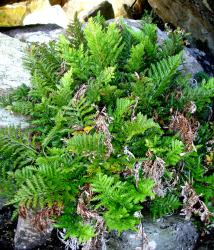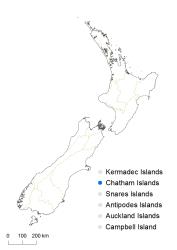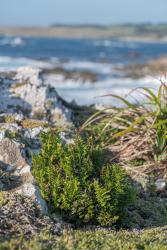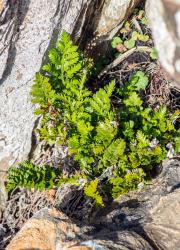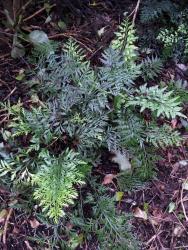Terrestrial or rupestral ferns. Rhizomes short, erect, bearing scales. Rhizome scales acicular with apical and lateral projections, 9–25 mm long, 0.5–3 mm wide, blackish-brown, clathrate. Fronds 100–980 mm long. Stipes 45–450 mm long, pale brown abaxially and green adaxially or occasionally red-brown throughout, bearing acicular scales with filiform apices and lateral projections. Rachises green or occasionally pale brown abaxially, scaly. Laminae 2–3-pinnate-pinnatifid, ovate or elliptic, abruptly narrowed to a pinnatifid apex, 35–600 mm long, 20–240 mm wide, dark shiny green on adaxial surface, lighter green on abaxial surface, coriaceous, bearing a few scattered scales, lacking hairs. Primary pinnae in 5–19 pairs below pinnatifid apex, usually overlapping; proximal pinnae and those at mid-lamina ovate or narrowly ovate; the longest below the middle, 20–175 mm long, 10–85 mm wide, apices acute or rarely obtuse, bases stalked; costae of primary pinnae winged in distal half. Secondary pinnae gradually decreasing in length along each primary pinna to the distal end; the longest proximal secondary pinnae narrowly ovate or ovate, 10–75 mm long, 4–20 mm wide, apices acute or obtuse, usually partly or completely divided into tertiary segments, bases stalked; the distal secondary pinnae linear or narrowly oblong, apices acute or obtuse, bases adnate. Tertiary pinnae linear or narrowly oblong or rarely obovate, 4–30 mm long, 2–10 mm wide, occasionally larger and partly divided into 2–4 ultimate segments, apices acute or obtuse, bases adnate or stalked in largest fronds. Sori submarginal; indusia 2–10 mm long, straight; free margins of indusia entire. Mean spore size 41–50 μm long, 26–32 μm wide; perispores prominently winged, sometimes with a few ridges.
Asplenium chathamense is confined to the Chatham Islands and occurs most frequently on coastal rocks and in coastal scrub. It is morphologically similar to both A. flaccidum and A. appendiculatum. It has firmer, more divided fronds that are held upright, and a terrestrial or rupestral habitat, whereas A. flaccidum subsp. flaccidum has pendent, limp fronds and usually an epiphytic habitat. It is more similar to A. flaccidum subsp. haurakiense, which occupies a similar habitat on coastal rocks in northern New Zealand. The two can be distinguished by the secondary pinnae, which decrease in size along the length of the primary pinnae in A. chathamense, whereas in A. flaccidum subsp. haurakiense the basal acroscopic secondary pinna is markedly longer than all the others. Also, the stipe scales in A. flaccidum subsp. haurakiense are shorter and have much thicker cell walls than those of A. chathamense. In general frond appearance, A. chathamense is most similar to A. appendiculatum, especially to subsp. maritimum, which occupies a similar coastal habitat. However, A. chathamense is tetraploid whereas A. appendiculatum is octoploid, and the spores of the latter have sharper, more numerous ridges (see Brownsey 1977; Large & Braggins 1991). Asplenium appendiculatum has not been recorded from the Chatham Islands (Brownsey 1977; de Lange et al. 2011).
Chatham Islands.
Altitudinal range: 0–250 m.
Asplenium chathamense is endemic to the Chatham Islands, where it grows most frequently along the coast, but extends up to 250 m on a few higher parts of Chatham Island. It has been recorded from Big Mangere, Little Mangere, Chatham, Little Sister, Pitt, Kokope and South East Islands, Star Keys and the Pyramid.
Grows most frequently on exposed coastal rocks and cliffs, but also on the ground, on stream banks, peat banks, logs, rock faces and in rock crevices under coastal forest, or rarely as a low epiphyte. It is found on basalt, schist, and limestone.
Asplenium chathamense was given a conservation status of Naturally Uncommon by de Lange et al. (2013).
There is evidence that A. chathamense hybridises with A. lyallii, A. obtusatum (Brownsey 1985; de Lange et al. 2011) and A. flaccidum subsp. flaccidum (newly recorded here). The latter combination is based on specimens (AK 300982 and WELT P022277) originally cited by de Lange et al. (2011) as A. flaccidum × lyallii.
n = 72 (Brownsey 1985).



